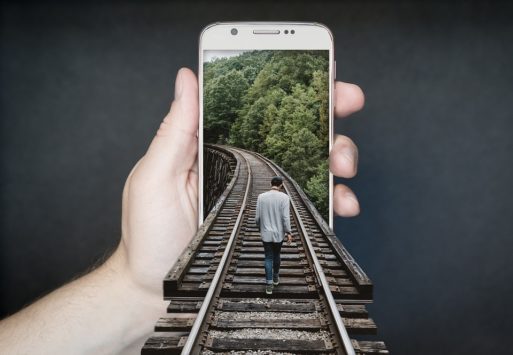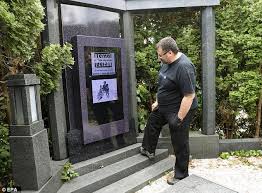
Technology is not a new thing. The world was forever changed when the printing press was invented, when electricity was discovered, and when the computer chip was produced. Technology continually changes every aspect of the world. In the world of grief, technology has affected three areas: how we mourn, how we remember, and how we memorialize the dead.
Technology Affects How We Mourn
The advances in technology allowed for the creation of the internet, and from there, an always burgeoning social media network. Social media has drastically affected how we mourn the dead, “for better or worse.”
How Technology Helps Us Mourn
The better? Now there are places that people can openly talk about grief and death. Many bereaved people find comfort in relationships established online with people in similar situations. Support groups abound. SevenPonds and other websites offer perspective and advice on the end-of-life experience.
How Technology Hurts the Mourning Process
The worse? Mourning is prolonged. Grief is trivialized and compartmentalized.
 Tessa Love, author of In the Wake: Technology is Changing the Way We Mourn, suggests that having an online profile is like creating an eternal presence on earth. In fact, 10,000 Facebook users die each day, leaving their profiles active. At that rate, within fifty to eighty years, there will be more Facebook profiles of the dead than the living. It’s already happening. Facebook “friends” are startled to be asked if they’d like to tag the dead person in a photo or invite them to an event. Or they might get a birthday notification for someone who has died.
Tessa Love, author of In the Wake: Technology is Changing the Way We Mourn, suggests that having an online profile is like creating an eternal presence on earth. In fact, 10,000 Facebook users die each day, leaving their profiles active. At that rate, within fifty to eighty years, there will be more Facebook profiles of the dead than the living. It’s already happening. Facebook “friends” are startled to be asked if they’d like to tag the dead person in a photo or invite them to an event. Or they might get a birthday notification for someone who has died.
Thus, the seemingly immortal digital presence of a person comes back, unexpectedly and at various intervals after they are dead, re-igniting the grief of those who are left behind.
In an article entitled No One Ever Talks about How Technology Impacts Grieving (and Why We Should) Rebecca Soffer recounts her shock — and then despair — when an old e-mail from her mother, dead for more than a year, appeared on her screen. A similar invitation to connect with her deceased dad popped up from LinkedIn. Soffer calls such incidences “digital dust.” She compares them with ripping the scabs off of deep wounds over and over again.
Social Media and the Platitudes of Grief

abedformyheart.com
Not only is mourning prolonged by social media, but the grief of those closest to the person who died can be almost negated by the platitudes and “mawkish kind of tributes” handed out on social media. In a moving, honest essay, The Space Between Mourning and Grief, author Claire Wilmot describes what happened when her sister died of a terminal illness. People who barely knew her sister started posted pictures and trite clichés even before the family could notify people personally.
Wilmot laments that such platitudes might help those on the outside rationalize a death, but they also “obscure the uncomfortable, messy reality of loss.” Those who offered cliches like, “she’s not suffering,” and “there’s a plan for everything” were people who had no connection to the misery that came in the last stages of her sister’s death. They compartmentalized the death from a safe distance. And their statements seemed to trivialize what happened, leaving her feeling angry and isolated. Wilmot writes, “Social media may have opened space for public mourning, but etiquette for ensuring that outpouring supports the bereaved (or at the very least does not make their situation more painful) has yet to develop.”
Technology Prolongs Our Memories and Our Mourning
 Years ago, the only memories of the dead might be handwritten letters. Then, photography came into being, so a bereaved person might have pictures to recall their dearly departed. Now, there are voice mail messages, texts, and video recordings which do, in many cases, soothe and encourage the grieving.
Years ago, the only memories of the dead might be handwritten letters. Then, photography came into being, so a bereaved person might have pictures to recall their dearly departed. Now, there are voice mail messages, texts, and video recordings which do, in many cases, soothe and encourage the grieving.
One woman, Eugenia Kuyda, memorialized her friend Roman Mazurenko after he died. She put all his text messages into a computer pattern-matching system that used artificial intelligence. She created a chatbox that “ended up being a tribute to him.” Mazurenko’s mother said that the chatbox technology reassured her. “I feel his voice through the lines of his texts.”
(If you believe that your loved ones would like to keep hearing from you after you have died, one American company called Afternote will send your pre-written messages long after you have gone.)
Technology is Changing Our Memorials
Today you can have live-streamed funerals and recorded ceremonies. So even if you can’t attend a funeral, you can feel like you have. Think how much the viewing at a funeral home has changed over the last 20 years. Most services are now accompanied by slide shows and music that showcase the life of the person who died.

Memorial with a video screen
Credit: dailymail.co.uk
And if a stone marker is not enough, you can now get monuments that include digital screens that highlight the life of the person who died. In some Asian countries, where space for memorials is limited, there are virtual cemeteries where you can go online and leave messages, visit a gravesite, or light virtual incense.
A Seattle company, Quiring Monuments, puts QR codes into tombstones. With a free, simple app on your smartphone, you can get pictures and stories about the person who died. Instead of looking at a stone marker with nothing but names and dates, you can learn something about the real person who once lived and laughed, worked and worried. Quiring envisions rows and rows of tombstones embedded with QR codes, telling the stories of “people who really deserve to have their stories told.”
And that’s just one of the technology-driven visions that celebrate individual stories long after a person has died. A strategy that probably prolongs, possibly soothes, and potentially changes the ways we mourn.

 Technology and Mourning: Changes in How We Mourn, How We Remember, and How We Memorialize Our Dead
Technology and Mourning: Changes in How We Mourn, How We Remember, and How We Memorialize Our Dead


 First the Wealth Gap, Now the U.S. Has a Growing Health Gap
First the Wealth Gap, Now the U.S. Has a Growing Health Gap
 How to Comfort A Dying Loved One
How to Comfort A Dying Loved One
 Our Annual Seven Holiday Gifts for Someone Who Is Grieving, 2024 Edition
Our Annual Seven Holiday Gifts for Someone Who Is Grieving, 2024 Edition














